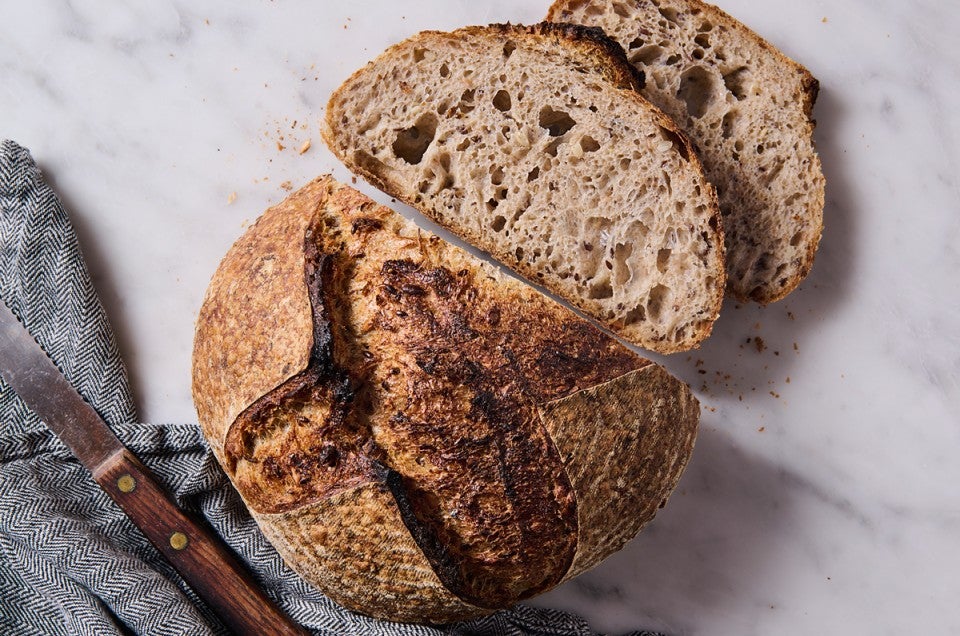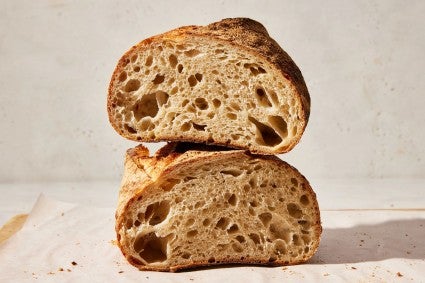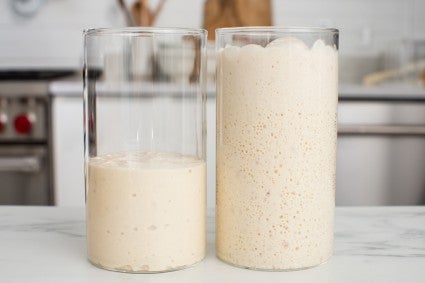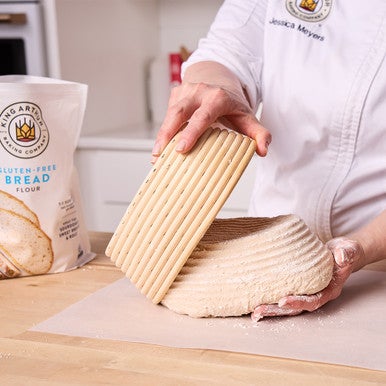Is sourdough bread healthy?
It’s complicated! But there are key differences between commercial yeast and sourdough breads.


In recent years, an interesting movement has been happening for some people who experience gluten sensitivity: They avoid wheat, except in the case of sourdough bread.
Amanda Paa, who created her gluten-free recipe blog Heartbeet Kitchen in 2011 after her doctors helped diagnose her with non-celiac gluten sensitivity, discovered in 2018 that she could, in fact, tolerate long-fermented sourdough bread without experiencing the skin rashes or other reactions that wheat typically caused. It was such a revelation that she fully shifted her recipe focus. “Sourdough became my passion,” she says, and she started sharing her recipes and teaching breadmaking classes via her blog. In her 2017 book Tartine All Day, Liz Prueitt shares a similar condition, prefacing a collection of gluten-free recipes by explaining that the only time she eats wheat is in naturally leavened sourdough loaves (like those her bakery Tartine is renowned for). Such stories have led many of us to wonder: Is sourdough bread “healthier” than other types of bread?

Before digging into this question, one caveat: “Healthy” is a highly subjective term, and as a passionate baker and eater, I’m not here to vilify one food over another. In the case of understanding why some people can enjoy sourdough but not other types of wheat breads, we’re examining the distinguishing characteristics of sourdough bread that may contribute to such a condition.
Breads made with commercial yeast, such as instant or active yeast, are often optimized for the quickest possible timeline — in extreme instances producing a loaf of bread in under an hour! Commercial yeast works by converting sugars and starches into carbon dioxide, alcohol, and organic acids, inflating the elastic dough with air bubbles as it proofs and bakes. This fast-acting quality is what makes commercial yeast great to bake with. You can make a loaf of bread relatively quickly, and it’s the ideal leavener for fluffy breads like Perfectly Pillowy Cinnamon Rolls, Japanese Milk Bread Rolls, and Big and Bubbly Focaccia.
Sourdough follows a similar process, but it takes a lot longer to do it. Because it’s made with the natural yeast in sourdough starter — made from just flour, water, and natural bacteria from the air, water, flour, and on our skin — fermentation works much more slowly, typically producing a loaf of bread over the course of 36 to 48 hours. During this time, the dough undergoes a number of changes that don’t happen with rapid-rise loaves.

“Sourdough starters are more microbially complex than commercial rapid-rise yeast,” explains Dr. Julia Skinner, author of Our Fermented Lives. “Since they contain wild microbes from the environment, they aren't just yeast, but also lactic acid bacteria.” That lactic acid bacteria is also what characterizes the fermented flavors in yogurt, sauerkraut, and kimchi, and while baking the bread in the oven ultimately kills off those probiotics, many beneficial nutrients remain, including protein and B vitamins. On top of that, there are recent studies suggesting that “postbiotics,” the deactivated probiotics, are beneficial to our microbiomes, too.
This long, slow process of fermentation also makes many nutrients in wheat more bioavailable to us as eaters. You can think of it as a form of pre-digesting our food, with the yeasts and bacteria in sourdough breaking down wheat’s starches and proteins so that they’re easier for our bodies to absorb and digest. In other words, “Your body doesn't have to work as hard,” says Dr. Skinner.
During fermentation, gluten, too, is meaningfully transformed through a process known as proteolysis. “The longer fermentation lasts, the more it will degrade the gluten,” says Dr. Elizabeth Klingbeil, an Assistant Professor of Instruction in the Department of Nutritional Sciences at the University of Texas-Austin. “There’s still gluten being developed,” she says, as the flour hydrates and the dough is kneaded and undergoes fermentation, “but the bacteria and yeasts break it down into an incomplete gluten protein.” This results in a lesser amount of complete gluten proteins compared to rapid-rise bread, and it could contribute to better digestibility for some people who are gluten sensitive.
What’s more, there could be a number of additional factors affecting the digestibility of wheat for people with non-celiac gluten sensitivity — and anyone else. Many long-fermented sourdough loaves tend to also have a portion of whole grains and thus are higher in fiber, and “more fiber in general helps with gastrointestinal issues,” says Dr. Jamie Horrigan, a GI Fellow at Dartmouth Hitchcock Medical Center. Or it could be because the long fermentation involved in sourdough also reduces the presence of fructans, which are one of the carbohydrates in wheat and a common FODMAP trigger that causes gas in the body.

And remember, there’s a difference between gluten sensitivity and celiac disease. According to Dr. Horrigan, studies indicate that celiac affects about 1% of the population (while non-celiac gluten sensitivity affects anywhere from 0.5% to 14% of the population) and for them, she said, gluten must be strictly avoided. Dr. Horrigan recommends getting tested for celiac even if you seem able to tolerate gluten in sourdough bread, because if it goes undiagnosed, it can have detrimental, long-term effects.
It’s important to speak with your doctor if you believe you’re sensitive to gluten, but Dr. Klingbeil also pointed out that placebos can be powerful. “There’s a psychological aspect to your gut health,” she says, “and our gastrointestinal functions are incredibly sensitive to stress.” If you notice that you seem able to tolerate sourdough bread while on vacation in Europe more than commercial loaves at home in the US, it may be due to being on vacation — and less stress.
Whether sourdough is “healthier” than other breads may be a matter of opinion, but the process of slow, natural fermentation does have meaningfully beneficial impacts on how our bodies are equipped to digest it. So if you can tolerate wheat and like eating sourdough bread, you can feel good about continuing to enjoy it.
Cover photo by Danielle Sykes; food styling by Liz Neily.



